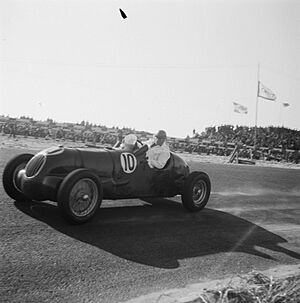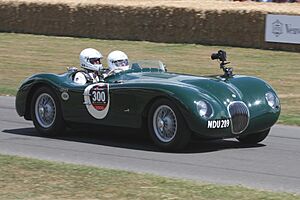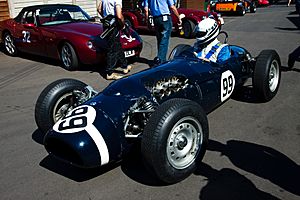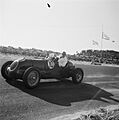Tony Rolt facts for kids
Quick facts for kids Tony Rolt |
|||||||||||||||||||||||||
|---|---|---|---|---|---|---|---|---|---|---|---|---|---|---|---|---|---|---|---|---|---|---|---|---|---|

Circuit Zandvoort, 7 August 1948. Tony Rolt in the 3.2-litre Aitken-Alfa, made by Peter Aitken (1912–47) based on an Alfa Romeo 8C bimotore
|
|||||||||||||||||||||||||
| Nationality | British | ||||||||||||||||||||||||
| Born | Anthony Peter Roylance Rolt 16 October 1918 Bordon, Hampshire, England, UK |
||||||||||||||||||||||||
| Died | 6 February 2008 (aged 89) Warwick, Warwickshire, England, UK |
||||||||||||||||||||||||
|
|||||||||||||||||||||||||
|
|||||||||||||||||||||||||
Anthony Peter Roylance Rolt (born October 16, 1918, died February 6, 2008) was a British racing driver, soldier, and engineer. He was a hero during World War II and stayed involved in motorsports for a long time, often working behind the scenes. Rolt was part of the team that developed the amazing Ferguson 4WD project, which led to great success. He also worked on many other engineering ideas.
When he passed away, Tony Rolt was the last person alive who had raced in the very first Formula One World Championship Grand Prix at Silverstone in 1950. He was also one of the last drivers to have won a major race before World War II. He won the 1939 British Empire Trophy when he was just 20 years old. He started his racing journey even earlier, at 16, in 1935, driving a three-wheeled Morgan in speed trials. Later, he won the famous 1953 24 Hours of Le Mans race and competed in three Formula One World Championship races.
Contents
Early Life and First Races
Tony Rolt was born in Bordon, Hampshire, England. He grew up in St Asaph in Denbighshire, Wales. He was the fourth child of Brigadier-General Stuart Rolt. Tony went to Eton College, a famous school, where he even got into trouble for having a car!
He started racing while he was still at Eton. He first drove a three-wheeled Morgan in trials. In 1936, he made his first track appearance at the Spa 24 Hours race. He shared a Triumph Gloria Vitesse with Jack Elliott. They finished 11th overall and fourth in their class. Tony raced there because he had lost his British driving license for speeding on a street in Denbigh!
In 1937, he raced a Triumph Dolomite and won the Coronation Trophy. After that, he bought a famous car called Remus from the Siamese princes, Chula Chakrabongse and Bira Birabongse. This car was made by ERA.
In one small race at Brooklands, a bolt fell off the ERA's exhaust pipe. Flames started to swirl around Tony's lap! He quickly took off his gloves, stuffed one into the hole, and still won the race. For 1939, he got another ERA car. He immediately won the 200-mile British Empire Trophy race at Donington Park.
World War II Hero
Tony Rolt joined the Royal Military College, Sandhurst, a military academy. In 1939, he became an officer in the Rifle Brigade. During World War II, Rolt was a lieutenant in charge of a scouting team. He was soon in heavy fighting in France in 1940. He helped defend the city of Calais. The soldiers defending Calais held out for three days. They stopped the German 10th Panzer Division from moving forward. This delay was very important because it gave time for the Dunkirk evacuation to happen.
Tony was captured and became a prisoner of war during the battle for Calais. For his brave actions, he received the Military Cross medal. For example, he helped a wounded friend while firing his machine gun at the advancing German troops.
Rolt was an amazing escape artist! He tried to escape seven times from different German prisoner-of-war camps. These included Laufen, Biberach, Posen, Warburg, and Eichstätt. Because he kept trying to escape, he was eventually sent to the super-secure prison, Oflag IV-C in Colditz Castle, in July 1943. In one escape attempt, he got very close to the Swiss border before being caught again. This is why he was moved to the fortress in East Germany. For his determined escape attempts, he was given a Bar to his Military Cross, which means he earned the medal a second time.
In early 1944, Tony Rolt was one of the main people behind the daring glider escape plan. This plan involved building a glider inside the prison to fly to freedom. However, in spring 1945, the American army freed the castle, so the glider wasn't needed.
After the war, Rolt left the army as a Major. He then focused on developing new car technologies.
Racing After the War
After the war, Tony Rolt started racing again. He drove an Alfa Romeo Bimotore and finished second in the 1948 Zandvoort Grand Prix. From 1949 to 1952, he worked closely with Freddie Dixon and Rob Walker. He formed an engineering partnership with Dixon and raced Walker's cars.
In 1950 and 1951, he shared a Nash-Healey car with Duncan Hamilton. They finished fourth and sixth at Le Mans in those races. From 1952 to 1955, Rolt raced Walker's dark-blue Connaughts. He was very successful in British races, winning many Formula Two and other types of races. However, his engineering work meant he couldn't race as much as he wanted.
In 1952, a big moment in his racing career happened. He was asked to join the Jaguar team. He said, "I'd proved quite competitive at Dundrod where I actually lapped the C-Type faster than Stirling [Moss]. Then they asked me who I'd like as my co-driver and I said Duncan. They said 'Duncan, you must be mad!' but he joined me in the team for 1952 and we always drove in long distance races together." Their first Le Mans race together for Jaguar was not good. They had an engine problem and had to stop early.
Formula One Racer
Tony Rolt competed in three Formula One World Championship races. These were the British Grands Prix in 1950, 1953, and 1955. Sadly, all three races ended with him having to stop early due to car problems.
At the 1950 British Grand Prix, which was the first-ever Formula One World Championship race, he started 10th. He was driving an ERA car. But the gearbox broke after only four laps. In the 1953 race, he again started 10th. This time, a part called a half shaft on his Connaught car broke after 70 laps. In his last Grand Prix in 1955, he shared the car with Peter Walker. Their Connaught started 14th but had a transmission problem and stopped after 18 laps.
Famous driver Stirling Moss believed that Tony Rolt would have been one of the best Grand Prix drivers if he had raced more often.
Le Mans Champion
Tony Rolt raced in every 24 Heures du Mans race from 1949 to 1955. He famously won the 1953 event in a Jaguar C-Type, sharing the car with Duncan Hamilton. At first, they were disqualified because they practiced in a Jaguar that had the same racing number as another car on the track at the same time. But they were allowed back into the race.
The Rolt and Hamilton team continued in 1954. They finished second to a Ferrari team in a Jaguar D-Type. This was despite a funny incident during a hail storm. Rolt realized he couldn't see well, so he stopped for a new visor. But a Ferrari was in its pit stop, so the team waved him out again. When Rolt stopped again on the next lap, his goggles were full of water! He jumped out of the car to put on a visor, and Hamilton quickly jumped in and drove off. Even after losing four laps, the Rolt/Hamilton D-Type finished less than four kilometers behind the winning Ferrari.
They also finished second for Jaguar in the 12 heures internationals – Voiture Sport Reims. However, they had to stop early from the 1955 Les 24 Heures du Mans while running in second place. Tony Rolt and his wife, Lois, saw the terrible 1955 Le Mans disaster that year. More than 80 people died after a Mercedes car crashed into spectators. After this, Tony focused on his engineering work. By the end of 1956, even though he was still part of the Jaguar team, Rolt stopped active racing to work full-time on the Ferguson development program.
Engineering Genius
After the war, Tony Rolt joined Freddie Dixon to form Rolt Dixon Research. They wanted to work on an idea they had before the war: four-wheel drive. Their company also helped create the viscous coupling, a special device for cars. This work eventually got support from the tractor maker Harry Ferguson. This led to the development of the Ferguson P99 four-wheel drive Formula One car.
Rolt later built 4WD racing cars for the Indianapolis 500 race in America. Ferguson transmissions were used in famous Indy Cars like the Lotus 56 and STP-Paxton Turbocar from 1964 to 1969. Tony Rolt, along with technical director Claude Hill and project engineer Derek Gardner, were important but often unseen heroes behind British racing technology.
When Ferguson Development closed, Rolt started his own company, FF Developments, in 1971. This company converted cars, vans, and ambulances to have four-wheel drive. In the 1980s, big car companies finally saw how good all-wheel drive technology was. FF Developments became a major partner for companies like Ford, Chrysler, Audi, Fiat, and General Motors.
In 1994, the business was sold to Ricardo. They continued to develop "smart" transmissions using Rolt's FFD and Ferguson's knowledge. Tony Rolt was very proud that the Audi sports cars, which have won many 24 Heures du Mans and American Le Mans Series races since 2000, used Ricardo transmissions.
The F1 Tractor
By the early 1960s, Rolt and FF Developments decided to build a 4WD racing car. They wanted to show how valuable four-wheel drive technology was. Tony Rolt helped design and test the Ferguson P99. Even though Rolt could drive the car fast enough for testing, Jack Fairman was brought in to race it. He raced it in the 1961 British Empire Trophy and the 1961 RAC British Grand Prix at Aintree. These races proved that four-wheel drive, combined with the special Dunlop Maxaret braking system, was much better in wet conditions.
The P99 was raced by Rob Walker Racing. It became the only 4WD car to win a Formula One race when Stirling Moss drove it to victory in the 1961 Oulton Park Gold Cup. This car was also the last front-engined car ever to win a Formula One race.
Tony Rolt was a very private person. He was charming and had a strong presence. He didn't like personal attention and never thought of himself as a hero for trying to escape Colditz. He avoided Colditz reunions. He simply believed it was his duty to try and escape. He would say, "Escaping was not a game. Nor was it fun. It was a duty." He enjoyed shooting and skiing.
Tony's wife, Lois, and his daughter, Nikki, passed away before him. He is survived by his other daughter, Angela, and his sons, David and Stuart. Stuart also raced Saloon cars in the 1970s and was chairman of the British Racing Drivers' Club (BRDC).
Tony Rolt was the last surviving driver from that very first World Championship Grand Prix held at Silverstone. He was also the last pre-World War member of the respected BRDC, having joined in 1936.
Images for kids





